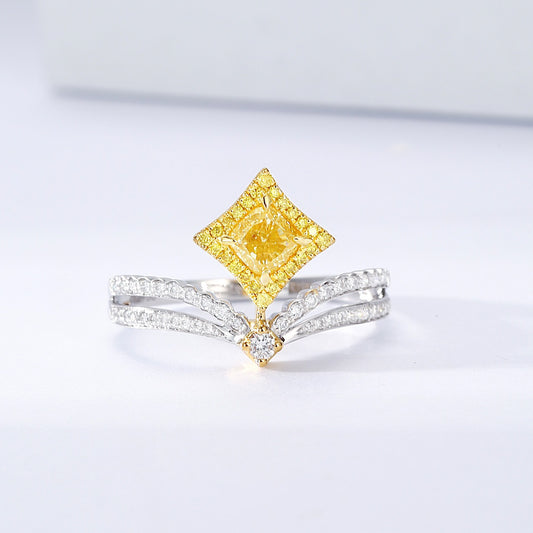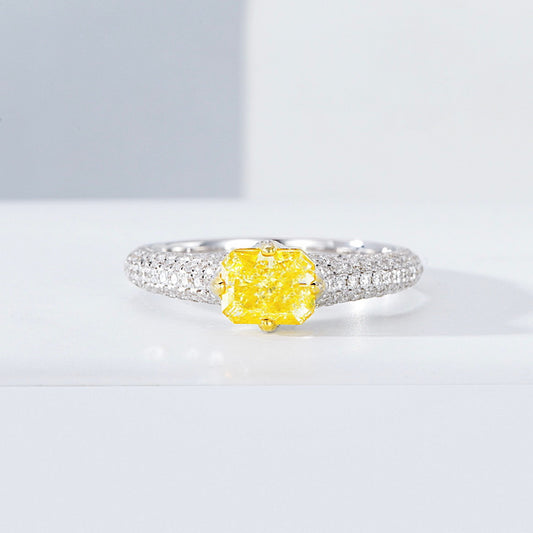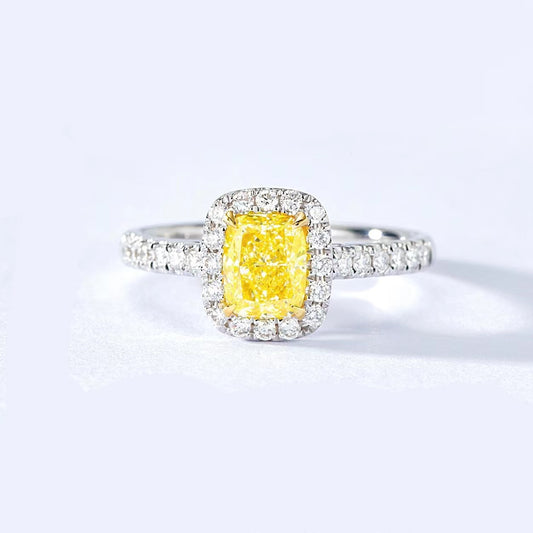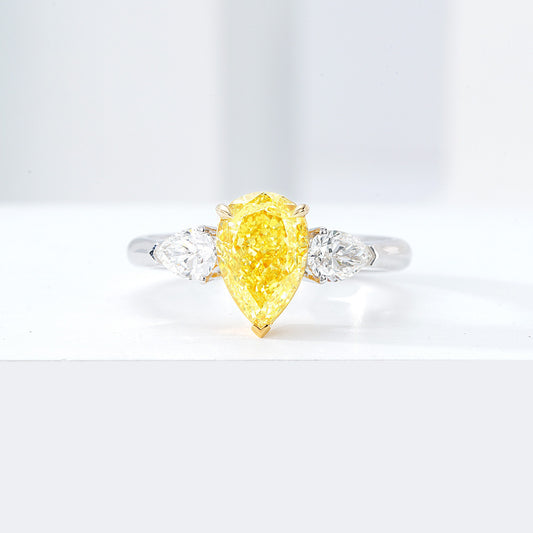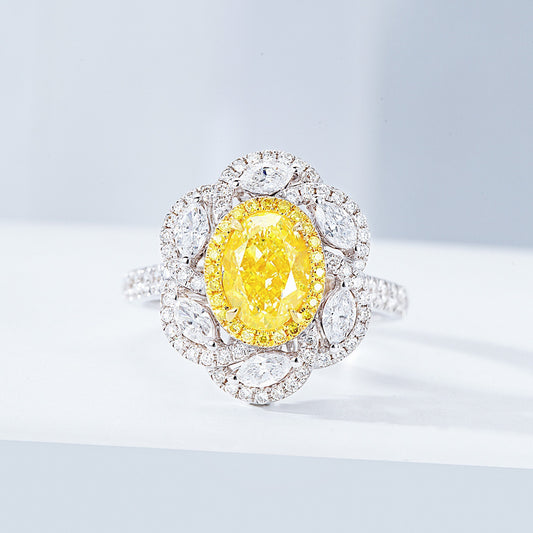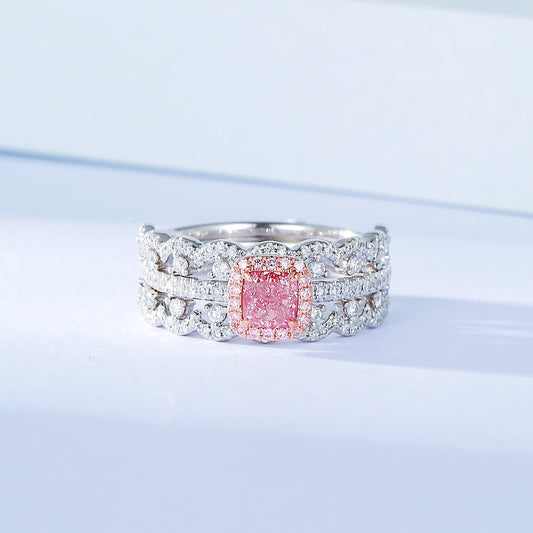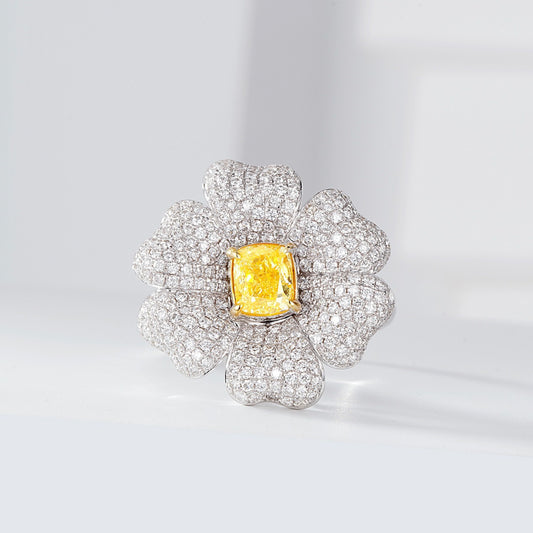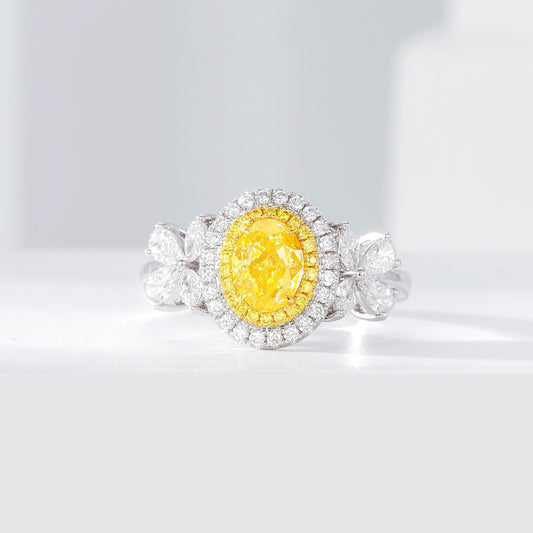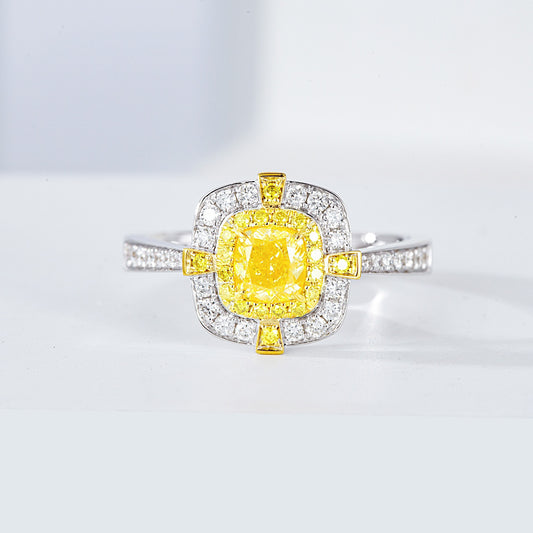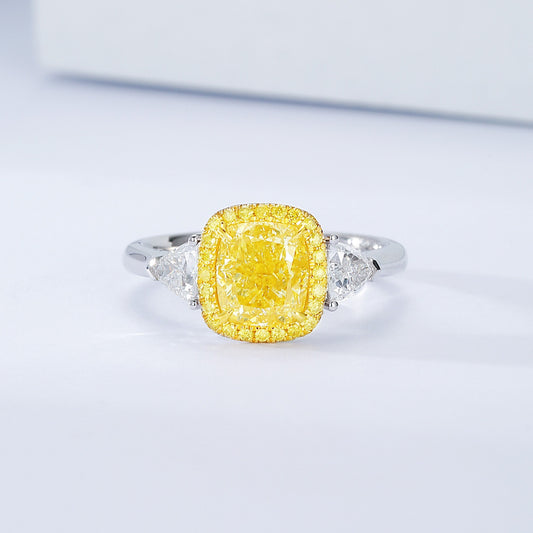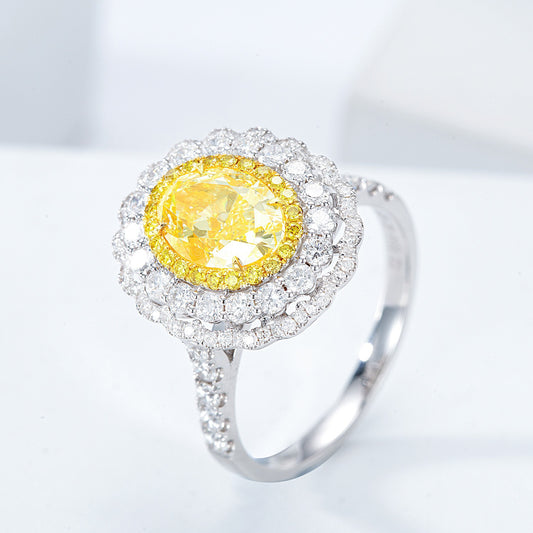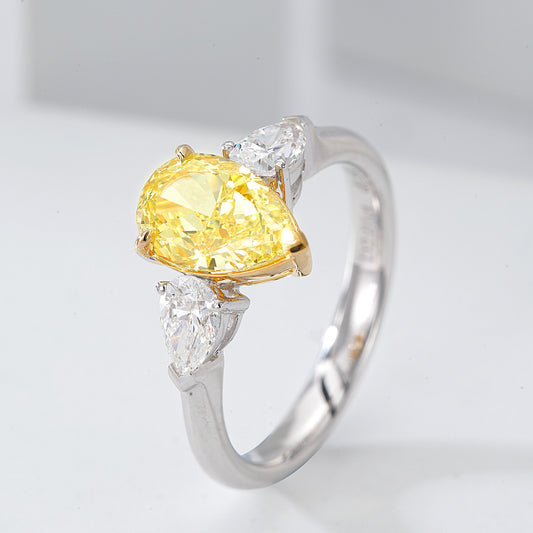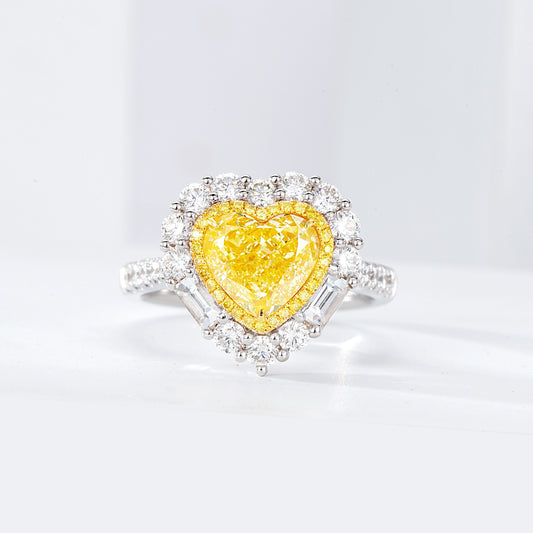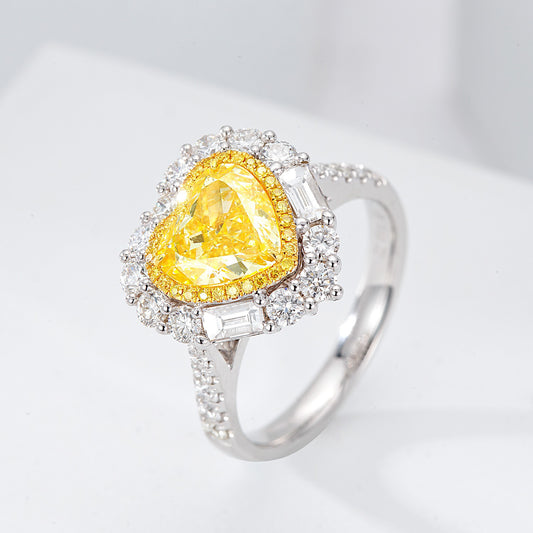-
Cushion Cut Yellow Diamond Halo Engagement Ring with Three Stone Setting
Such a fascinating three stone ring has a two-carat, yellow cushion-cut diamond right in the center emitting warmth and light. The arrangement creates a classic but lively contrast between it and other two completely matched white diamonds. A thin halo encloses the diamond in yellow, giving it more shades and making it look more colorful. A luxury Yellow Diamond Halo Engagement Ring with Three Stone Setting with a total weight of 2.60 carats, showcasing a certified 2.00 carats cushion cut diamond.- From $5,460.00
- From $5,460.00
- Unit price
- per
-
Oval Cut Yellow Diamond Engagement Ring with Pavé Halo Setting in 18K White Gold
This exquisite 2 carat oval yellow diamond engagement ring is the epitome of timeless elegance. The vivid yellow diamond is beautifully showcased within a luxurious double pavé halo setting, amplifying its radiant sparkle. The white gold band offers a classic touch while highlighting the brilliance of the centerpiece. Ideal for engagements, this ring is designed to symbolize your most cherished moments with elegance and sophistication.- From $4,790.00
- From $4,790.00
- Unit price
- per
-
Three Stone Pear Shaped Yellow Diamond Engagement Ring in 18K White Gold
Elevate your style with a statement that surpasses its expectations through this stunning two-carat fancy yellow pear shaped center stone three-stone ring. The vivid yellow diamond dominates the focal point, bolstered by two pear shaped diamonds, one at each flank. The graceful polished white gold architecture of this piece combines the beauty of the past with the appearance of the present. In such an engagement style ring or for a special occasion, this ornament is rich in aura and grace. An exquisite Cushion Cut Pink Diamond Engagement Ring with a total weight of 2.60 carats, showcasing a certified 2.00 carat cushion cut diamond.- From $3,980.00
- From $3,980.00
- Unit price
- per
-
Heart Shaped Yellow Diamond Engagement Ring with Pavé Halo Setting in 18K White Gold
This ring features one heart shape stone and the main of them are beautiful massive cushion cut yellow diamonds that sparkle in the ring of 18 kt gold. The yellow diamonds of the ring are vivid and very sophisticated, making it a lovely piece to be worn as a representation of rich and enduring love. This classic pattern designed for very special anniversaries or moments, however also all diamonds important as focusses on their brilliance with the ageless touch. A charming Heart-Shaped Yellow Diamond Engagement Ring with a total weight of 3.11 carats.- From $4,950.00
- From $4,950.00
- Unit price
- per
2 Carat Diamond Engagement Rings
2-carat diamond engagement rings featuring fancy colored diamonds offer a stunning combination of size and vibrant color, making them an exceptional choice for those seeking something truly unique. These larger diamonds, available in a range of captivating hues like yellow, pink, and green, provide a bold and eye-catching statement that is sure to stand out. The rich colors of these diamonds add an extra layer of personality and distinction, perfect for those who want their ring to reflect their individual style.
Our collection of 2-carat fancy colored diamond engagement rings is designed to highlight the beauty and rarity of these exquisite stones. Whether set in a classic solitaire or an intricate halo design, these rings offer a luxurious and sophisticated look that exudes elegance. The larger carat weight combined with the mesmerizing color ensures that these rings are not only a symbol of love but also a stunning piece of jewelry that will be cherished for a lifetime.
FAQs about 2 Carat Diamond Engagement Rings
The cost of a 2-carat diamond can vary widely based on several factors, including the diamond's cut, color, clarity, and whether it is a natural or lab-grown diamond. Here's a detailed breakdown:
Natural Diamonds:
- Color Influence: The color of the diamond plays a significant role in determining its price. For example, yellow diamonds are generally more affordable, while pink diamonds, due to their rarity, tend to be much more expensive. Green diamonds are consistently priced high, reflecting their rarity and desirability.
- Low-End: For a 2-carat natural diamond with lower grades in color, clarity, or cut, prices typically start around $8,000 to $12,000. This range might include diamonds with less desirable colors or visible inclusions.
- Mid-Range: A well-cut, high-quality 2-carat diamond with good color (such as a yellow diamond with a vibrant hue) and clarity (VS1-VS2) usually costs between $15,000 and $30,000. This range balances quality and price, offering a beautiful diamond with impressive brilliance.
- High-End: Top-tier 2-carat diamonds, especially those with rare colors like intense pink or green, and excellent cut, clarity, and color grades (D-F for white diamonds or high saturation for colored ones) can cost $35,000 or more. These diamonds are nearly flawless and offer maximum beauty and sparkle.
Lab-Grown Diamonds:
- Price Range: Lab-grown 2-carat diamonds are significantly more affordable, typically ranging from $5,000 to $15,000, depending on the quality of the cut, color, and clarity. Lab-grown yellow or pink diamonds offer a more budget-friendly option compared to their natural counterparts, but green lab-grown diamonds still maintain a higher price due to their complexity.
Final Thoughts: The amount you should expect to pay for a 2-carat diamond depends on the diamond's quality, color, and whether you choose a natural or lab-grown option. Natural diamonds are more expensive due to their rarity, with color playing a crucial role in price variation. Yellow diamonds tend to be more affordable, while pink and green diamonds command higher prices. Lab-grown diamonds provide a more budget-friendly alternative with excellent quality and a wide range of color options.
A 2-carat diamond is an excellent choice for an engagement ring, offering a significant and eye-catching presence. Here’s why:
- Impressive Size and Impact: A 2-carat diamond is noticeably larger than the average engagement ring stone, which typically ranges from 0.5 to 1.5 carats. This size makes a bold statement and is ideal for those who want their ring to stand out.
- Versatility in Design: A 2-carat diamond can be beautifully showcased in a variety of settings. Whether in a classic solitaire, a halo design, or a more intricate luxe style, the diamond will have a striking visual impact. The size allows for a lot of creative freedom in the design, enhancing the ring’s overall elegance and appeal.
- Value and Rarity: Larger diamonds, like those at 2 carats, are rarer and often considered more luxurious. This makes a 2-carat diamond not only a significant symbol of love and commitment but also a valuable investment.
- Considerations: While a 2-carat diamond is a fantastic choice, it’s important to consider factors like cut, color, and clarity to ensure the diamond has maximum brilliance. The quality of these aspects can greatly affect the appearance and overall beauty of the diamond.
In summary, a 2-carat diamond is a great choice for an engagement ring if you’re looking for something substantial, elegant, and luxurious. It offers both visual impact and lasting value, making it a popular choice for those wanting to make a grand gesture.
The amount a guy might spend on an engagement ring varies widely based on personal circumstances, cultural expectations, and individual preferences. Here are some common factors that influence this decision:
- Traditional Guidelines: A long-standing guideline suggests spending about two to three months' salary on an engagement ring. However, this is not a hard and fast rule, and many people choose to spend more or less depending on their financial situation and priorities.
- Average Spending: In recent years, the average amount spent on an engagement ring in the United States has been around $5,000 to $6,000. This figure can vary significantly depending on the region, the couple’s financial situation, and the type of ring.
- Personal Budget: Ultimately, the amount spent on an engagement ring should reflect what the buyer is comfortable with. Some may opt for a more modest ring to save for other expenses, such as a wedding or a home, while others may prioritize a more expensive ring if that aligns with their values and financial situation.
- Quality Over Size: Many people prioritize the quality of the diamond (cut, color, clarity) over the carat size, focusing on finding a ring that has the most brilliance and beauty within their budget.
Final Thoughts: There’s no set amount that a guy should spend on an engagement ring. It’s a highly personal decision that should take into account financial comfort, personal values, and the preferences of the partner who will be wearing the ring. The most important factor is choosing a ring that symbolizes the commitment and love shared between the couple, regardless of the price tag.
The perception of how many carats is 'a lot' for an engagement ring can vary depending on cultural norms, personal preferences, and regional trends. However, here’s a general breakdown:
Standard Size Range:
- In many places, the typical engagement ring ranges from 0.5 to 1.5 carats. Within this range, a 1-carat diamond is often considered a classic and desirable size.
When It’s Considered 'A Lot':
- 2 Carats: A 2-carat diamond is generally considered a larger and more luxurious size for an engagement ring. It’s often seen as a significant upgrade from the more common 1-carat stone, and it makes a bold statement.
- 3 Carats and Above: Rings with diamonds of 3 carats or more are typically viewed as particularly large and extravagant. This size is often associated with high-end luxury and can be quite rare and expensive.
Influencing Factors:
- Design and Setting: The perception of size can also be influenced by the ring’s design. For example, a halo setting or certain diamond shapes like oval or pear can make a diamond appear larger, enhancing its impact.
- Cultural Expectations: In some cultures or social circles, larger diamonds (2 carats and above) are more common and expected, while in others, a 1-carat diamond might already be considered quite substantial.
Conclusion: A diamond of 2 carats or more is generally considered 'a lot' for an engagement ring, representing a significant and luxurious choice. However, what qualifies as 'a lot' can depend on personal preferences, cultural norms, and the design of the ring itself.
- Choosing a selection results in a full page refresh.
